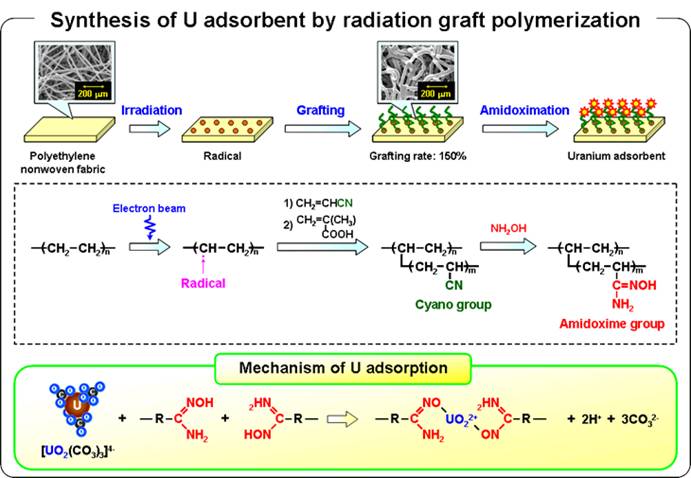Breeder reactors: A renewable energy source by Bernard L. Cohen, American Journal of Physics, 1983 (H/T Crowlspace Uranium can last for 5 billion years with a withdrawal rate of 6,500 tonne per year from the oceans [with breeder reactors this would be double current world electricity usage]. This estimate does not include using Thorium which is more common in the earth’s crust than Uranium.
UPDATE: Japan is working towards large scale uranium from seawater using genetically modified seaweed.
It now seems quite certain that uranium can be extracted from the ocean at well below $1000 per pound ($100-800/lb in recent analysis of Japan’s extraction process) and there is even some optimism that it can become competitive at current market prices ($65/lb). It is clear, then, that uranium from seawater must be considered as a completely acceptable fuel for breeder reactors, contributing less than 1% to the cost of electricity. In terms of fuel cost per million BTU, even at $400/lb the uranium cost is only 1.1 cents.
Seawater contains 3.3×10–9 (3.3 parts per billion) of uranium, whence the 1.4×10**18 tonne2 of water in the oceans contains 4.6×10**9 tonne of uranium. The energy content of uranium burned in a breeder reactor is 1 MW day/g, or 1000 GW day/tonne; at 37% efficiency, readily achievable in a breeder reactor, this is 1.0 GWe yr/tonne (GWe = GW of electricity). All of the world’s present electrical usage, 2325 GWe [372 GWe of nuclear make up 16% of world electrical supply] , could therefore be supplied by the uranium in seawater for (4.6×10**9/2325) = 1.98 million years.
At ten times the power level, it would last 198,000 years and at one hundred times it would be 19,800 years.
Rivers bring 3.2×10**13 tonne/yr of water into the oceans, and their uranium content averages 1.0×10–9 (one part per billion), whence a total of 3.2×10**4 tonne/yr of uranium enter the oceans from this source.
We can withdraw 16 000 tonne/yr of uranium from seawater continuously for hundreds of millions of years. This is enough to produce 16 000 GWe or 480 quadrillion BTU per year, which is 6 times the world’s present electricity usage, and almost the world’s present total energy consumption.
FURTHER READING
Uranium from seawater.


Using algae blooms to concentrate uranium from seawater was considered in a 1973 paper by researchers from the Nuclear Research Center Juelich (KFA), Juelich, Germany.
Another calculation of how long nuclear resources would last using different reactor technology
Recent uranium and nuclear power news roundup
75% of new power added from 2010-2020 is projected to not be in the OECD. No political uncertainty in China, Russia, India.
Of the nuclear reactors being built (36) or where millions have already been spent on planning for imminent build start (93).
Only 12 are expected in the USA.
31 in China
17 Russia
16 India
13 Japan
8 South Korea
5 Canada
The rest in 14 other countries (1-3 each).
The future of nuclear power does not rest in the United States. The United States should adopt nuclear power as a safe and clean energy source, but world nuclear power usage will carry on even if the United States makes the wrong choice.

Brian Wang is a Futurist Thought Leader and a popular Science blogger with 1 million readers per month. His blog Nextbigfuture.com is ranked #1 Science News Blog. It covers many disruptive technology and trends including Space, Robotics, Artificial Intelligence, Medicine, Anti-aging Biotechnology, and Nanotechnology.
Known for identifying cutting edge technologies, he is currently a Co-Founder of a startup and fundraiser for high potential early-stage companies. He is the Head of Research for Allocations for deep technology investments and an Angel Investor at Space Angels.
A frequent speaker at corporations, he has been a TEDx speaker, a Singularity University speaker and guest at numerous interviews for radio and podcasts. He is open to public speaking and advising engagements.


